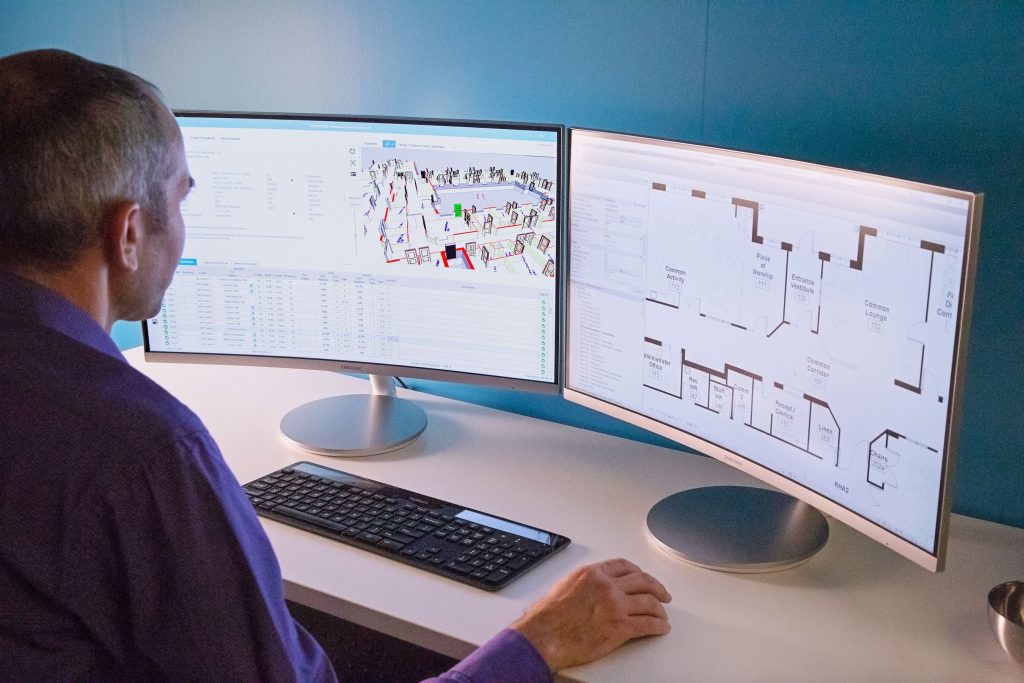Sector - Health & Safety
Compliant construction: BIM and fire door safety

Paul Thompson, Head of Specification & Openings Studio for ASSA ABLOY Opening Solutions, discusses the duty of contractors to ensure a building’s fire doors are installed correctly, and how Building Information Modelling (BIM) holds the key to ensuring compliance.
Since its introduction in 2022, the Building Safety Act has overhauled existing regulations, with an aim to create lasting change and make clear how buildings should be constructed, maintained and made safe.
This has given contractors the responsibility of ensuring that the products they install meet these requirements, as well as guaranteeing a safe working environment during the construction phase.
When installing doorsets in particular, there are a range of standards that must be adhered to, as part of the Regulatory Reform (Fire Safety) Order 2005 (Fire Safety Order).
Many contractors are turning to technology to help, with BIM providing the tools needed for more efficient planning, design and building processes, as well as providing the essential ‘golden thread’ approach outlined by Dame Judith Hackett in her report, ‘Building a safer future’.
So, what are the latest innovations in BIM, and how are they assisting contractors when it comes to installing compliant fire doors within a building?
Adoption of BIM
BIM is a tool that reduces waste and risk of error and facilitates the sharing of detailed information throughout the design, construction, and operational phases of a project, which ultimately results in safer and more efficient buildings.
The latest NBS Digital Construction Report[1] found 70% of construction professionals use BIM. What’s more, contractors (41% of which are main contractors) are the group most likely to have been involved with tasks or platforms such as common data environments (CDEs).
Main contractors will often have their preferred CDE and manage much of the information sharing on a project. They are also more likely to be involved in BIM Execution Plans (73%) and detailed responsibility matrices (60%), whether that involves receiving or developing them.
When it comes to installing doorsets and ironmongery in particular, using BIM-enabled tools can offer many advantages. Having intelligent, data rich environments in which to collaborate throughout the stages of design, manufacture, installation and ongoing maintenance, provides contractors with a powerful tool to ensure that every fire door installed is compliant with current standards.
Openings Studio
ASSA ABLOY’S Openings Studio™ provides a direct interface with the building design model and can be used to extract, develop and update all relevant door design information within the model, including configurations, hardware and performance criteria against each individual door.
Utilising this digital collaboration tool enables the specifier to work closely with the manufacturer in real time to develop the design intent through to a compliant specification.
The application provides visual representations of not only the bespoke product but also indicative imagery of product in-situ within the 3D model. Each asset carries all relevant technical and design data, and as this is a live working environment it captures and logs progressive design changes throughout design and construction.
ASSA ABLOY’s manufacturing facilities can seamlessly use this data to provide product specific cost information but most importantly manufacture and supply the door solution in accordance with the latest design intent.
An extension to Openings Studio, through a mobile app, directly accesses this data to capture production quality inspections and assist during the door installation process, ensuring full validity of the finished product prior to project completion.
What’s more, every door logged in Openings Studio is automatically assigned a unique asset tag, which can be affixed to the door as either a QR code or RFID Tag, enabling direct access to the door details, including installation, inspection, and service history.
The asset tag functionality enables direct access from the mobile app to information such as product specification, hardware schedule, product information, inspection reports, digital images, and change management tracking.
Ultimately, BIM is not just a technological advancement; it is a critical component of a contractor’s professional responsibility. By using the tool, a contractor can:
Mitigate risks
Ensuring that all specified products are compliant with current standards significantly reduces the risk of safety failures and legal repercussions. BIM and Openings Studio provide the necessary tools to verify product certifications and compliance, allowing contractors to mitigate potential risks associated with non-compliant materials.
3D models provide clear visualisations of where fire doors are located and how they interact with other building components. This helps contractors and installers understand the exact requirements and constraints, reducing the risk of improper installation. This risk mitigation is crucial for protecting both the safety of building occupants and the reputation of the contractor.
Enable collaboration and coordination
BIM facilitates better collaboration among stakeholders on a project, from architects to engineers, contractors, facilities managers and fire door inspectors. This ensures that everyone has access to up-to-date information and can coordinate effectively to address any issues related to fire door placement, design, and compliance.
BIM tracks changes in the design and construction process, ensuring that any modifications to the building plan are updated across all documentation to maintain compliance.
By providing detailed information and preventing costly mistakes, BIM also helps in budgeting for the correct fire door specifications and installations, avoiding expensive retrofits and modifications later.
Adhere to British standards
BIM provides a centralised repository for all documentation related to fire doors, including certificates, installation manuals, and maintenance schedules. This makes it easier to manage and retrieve necessary documents for compliance inspections and audits.
BIM models can also be integrated with regulatory databases to automatically check compliance with fire safety regulations and standards. This ensures that fire doors are specified and installed according to the current guidelines.
Ensure a safe working environment
It is a contractor’s duty to ensure a safe working environment during the construction phase of a project. Contractors can use BIM to create a virtual model of the construction site, which includes the location and specifications of fire doors.
This allows workers to understand the exact placement and requirements before beginning installation, reducing errors. Safety protocols can also be integrated, advising on specific measures to be taken and any personal protective equipment (PPE) required for the task.
Lifecycle management
BIM supports the entire lifecycle of a building, from design through construction to operation and maintenance. For fire doors, this means that contractors can ensure they are properly installed and that facility managers have the information needed for ongoing inspections, testing, and maintenance.
Ultimately, BIM provides confidence and assurance that buildings will adhere to the highest safety standards. By embracing digital platforms and the capabilities offered by ASSA ABLOY’s Openings Studio™, contractors can prevent future tragedies and ensure buildings are safe, compliant, and resilient.
Through this proactive approach, contractors can contribute to a safer built environment, reinforcing their commitment to public safety and professional excellence.
If you would like to read more stories like this, then please click here
Related Articles
More Health & Safety News
- Government finalises RAAC removal programme
18 Nov 25
Definitive timeline for the complete removal of Reinforced Autoclaved Aerated Concrete (RAAC) from all affected
- Construction mental health consultation
29 Oct 25
The Construction Leadership Council (CLC) has launched a mental health in construction consultation.
- “Serious gaps” found in protecting workers from excessive noise
3 Oct 25
Three-quarters of noisy workplaces lacked essential knowledge on maintaining hearing protection equipment, inspections have found.






